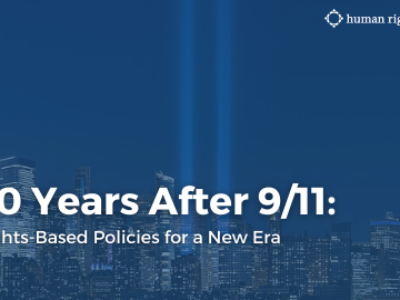State Department Legal Adviser on International Law and the Next Administration
Last Friday at the annual “International Law Weekend” at Fordham University School of Law, State Department Legal Adviser Brian Egan joined Professors Jennifer Daskal and Oona Hathaway and Human Right First’s International Legal Counsel Rita Siemion for a panel discussion on “The Post-9/11 Wars: Unresolved International Law Issues Facing the next Administration.”
Moderated by New York Times Washington correspondent Charlie Savage, the panelists covered a broad range of national security issues, including the Obama Administration’s targeted killing program, efforts to close the Guantanamo Bay detention facility, controversial provisions in the Department of Defense’s 2015 Law of War Manual, the future detention of ISIS fighters, and whether the next Congress would pass a new Authorization for the Use of Military Force (AUMF) tailored to the conflict with ISIS.
After acknowledging that other nations do not all share the United States’ view on the legal framework that applies to lethal strikes outside war zones, Egan outlined the Obama Administration’s position, reiterating what he had discussed in more detail earlier this year in a speech at the American Society of International Law’s annual meeting. Egan explained that while the Obama Administration believes the law of armed conflict governs strikes against combatants even in non-battlefield settings, the administration had adopted standards that are stricter in some respects than those required by the law of armed conflict.
These stricter standards are set out in the administration’s Presidential Policy Guidance (PPG). Released earlier this year, the PPG seems to bring the government’s targeting rules more into line with human rights law standards, requiring near certainty of no civilian harm caused by strikes outside “areas of active hostilities,” and capture rather than lethal force when feasible. Siemion noted that one of the reasons for the more restrictive policy is that many U.S. partner nations do not agree with the U.S. view that the law of armed conflict follows fighters around the world, permitting the United States to use lethal force against them as a first resort. This sparked a live Twitter debate with several experts, some in attendance at the panel and others in Washington and the United Kingdom, over whether any other states accept the U.S. view.
Daskal praised the administration for releasing the PPG but noted that it remains a non-binding document and that questions persist over how it is operationalized. While the PPG details the many layers of review and approval required before a strike is authorized, it does not, for example, provide definitions of key terms such as “near certainty” of no civilian harm, when “capture is not feasible,” and “areas of active hostilities”—which Egan said are currently Afghanistan, Iraq, and Syria.
Responding to an audience question on this concern, Egan conceded that while the Obama Administration has sought to be transparent, the lack of specificity in the PPG is “one area where we need to be more transparent.”
Hathaway led the discussion on the 2015 Department of Defense Law of War Manual, which has received a substantial amount of criticism from scholars and other commentators. Savage noted that neither the State Department nor the National Security Council (Egan’s previous post) had endorsed the manual. Egan admitted that the manual is “very long and hard to read,” but referred to it as a “living document,” noting the active effort within the Department of Defense to address criticisms. Indeed, the department made changes to the manual earlier this year in response to concerns raised over provisions on the protection of journalists in war zones.
The panelists also discussed the prospects for closing Guantanamo before President Obama leaves office in January. While Savage and Egan expressed some skepticism about whether closure was still possible under Obama, Siemion argued that if the president wanted to get it done he could. Sixty detainees remain at the controversial facility, 20 of whom have already been approved for transfer to third countries.
As Ryan Goodman noted over at the Just Security blog, Egan’s willingness to engage with national security law experts in a public forum on these complex issues is commendable. Egan’s efforts to clarify the Obama Administration’s view on the boundaries of U.S. wars and law and policy authorities add to the endeavors of other administration officials in various speeches, (here, here, here, here, here, here, and here for example), as well as court filings, Congressional testimony, White House factsheets, and a draft AUMF against ISIS.
As President Obama approaches the final months of his presidency and prepares to hand over the reins to a new administration, he should memorialize these positions in a single executive branch document that sets clear parameters on the use of wartime powers for countering terrorism. Providing clarity on who we are at war with, where, and on what legal basis is paramount to U.S. democratic responsibility and global legitimacy.

